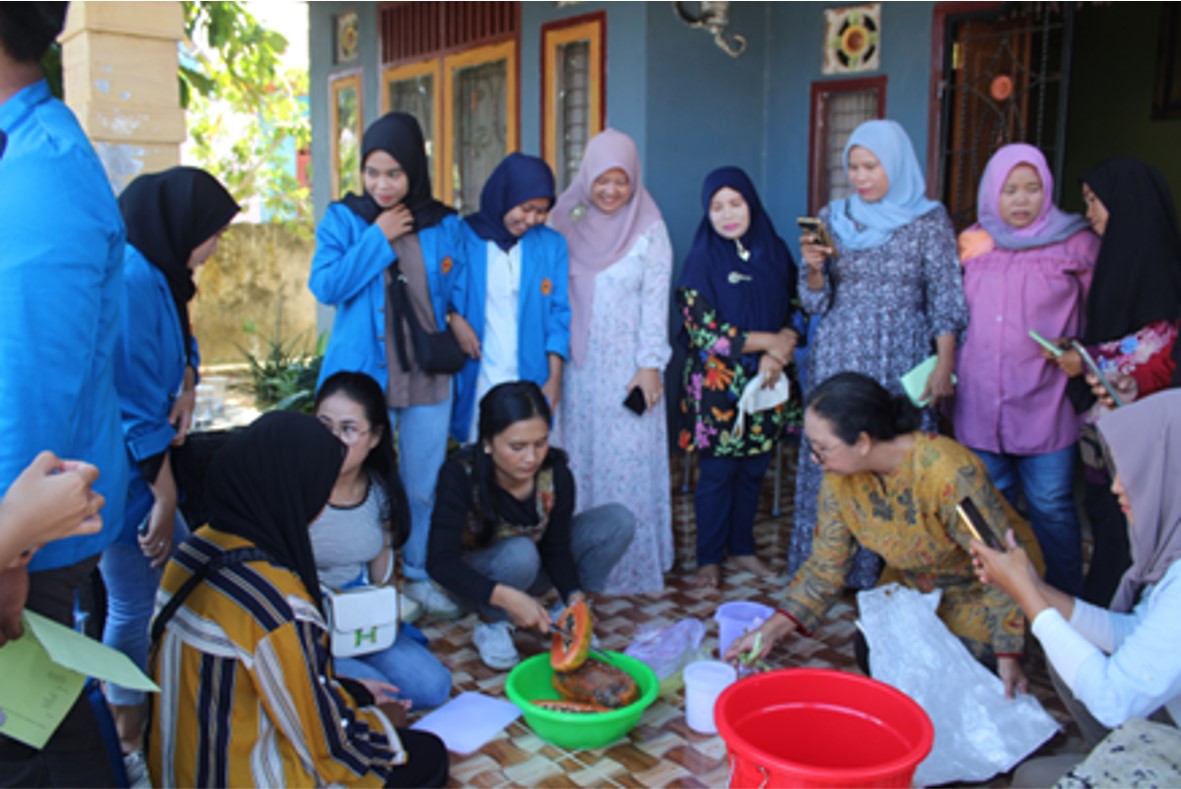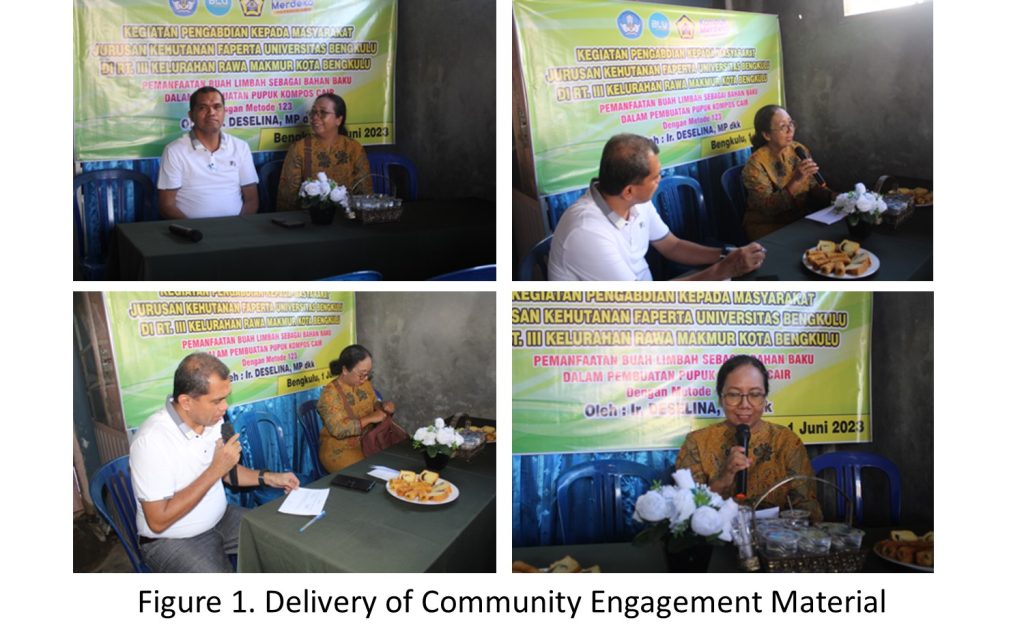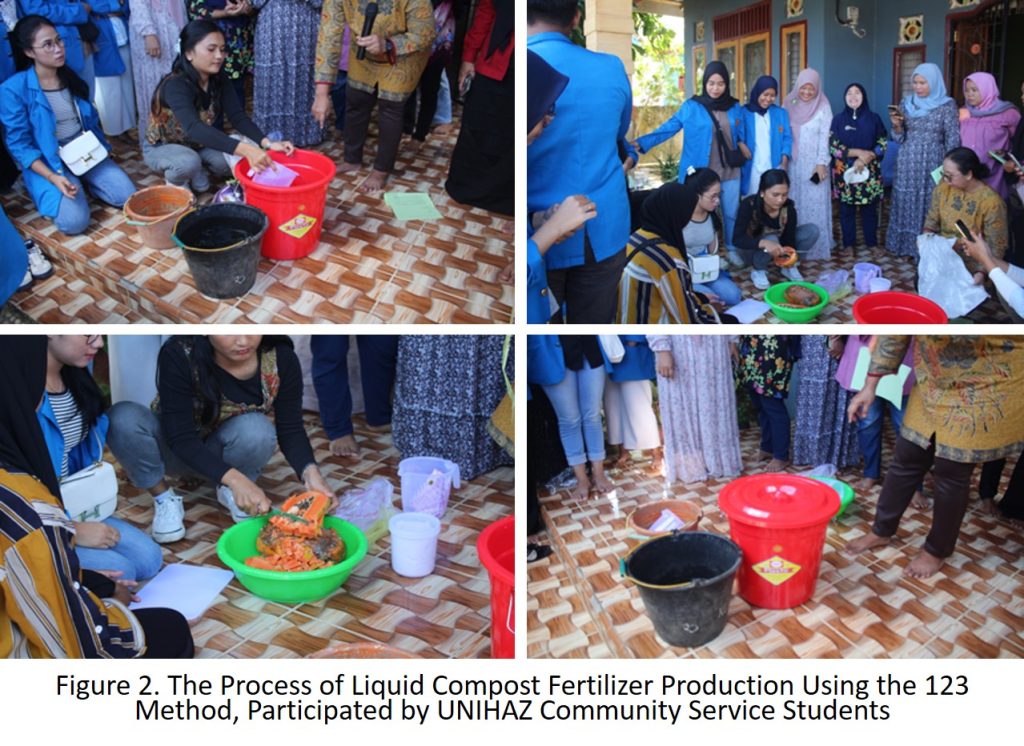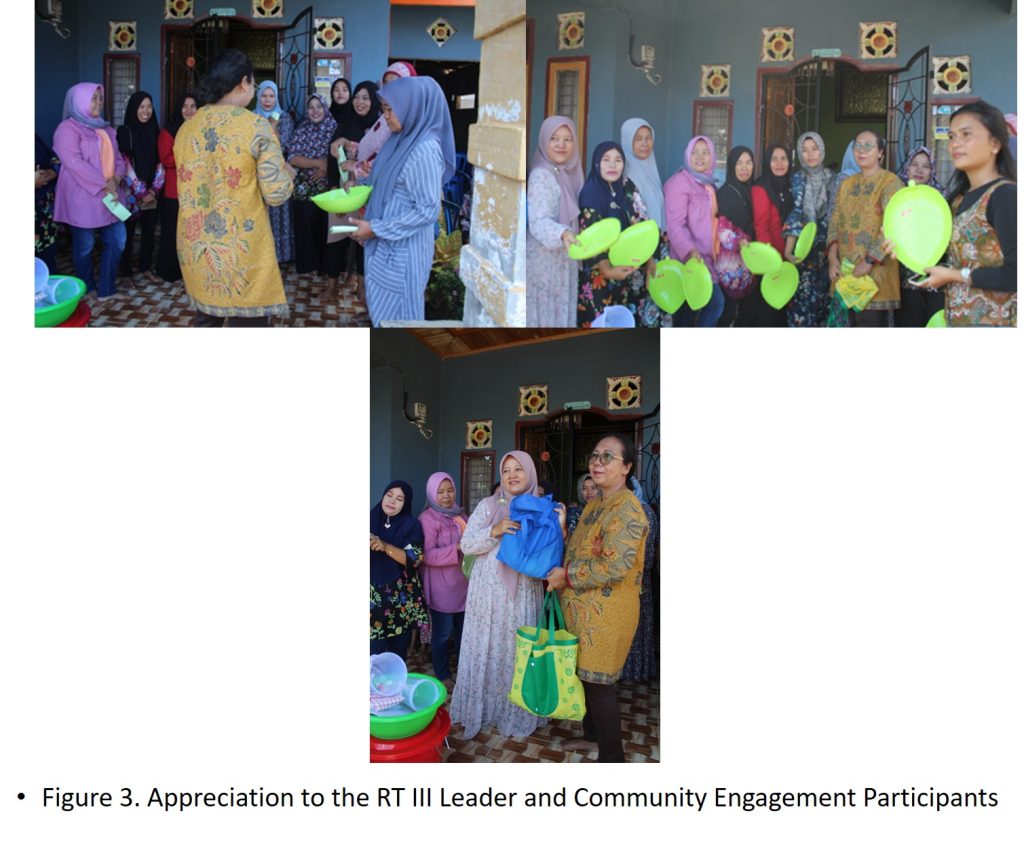
UTILIZATION OF WASTE FRUIT AS RAW MATERIALS IN LIQUID COMPOST FERTILIZER PRODUCTION USING THE 123 METHOD.
UTILIZATION OF WASTE FRUIT AS RAW MATERIALS IN LIQUID COMPOST FERTILIZER PRODUCTION USING THE 123 METHOD.
(Community Service Activity PNBP Funding, Faculty Of Agriculture 2023)
Deselina, Ridwan Yahya, Agus Susatya
Department of Forestry, Faculty of Agriculture, University of Bengkulu
Fruits are rich in vitamins and minerals essential for the body. The body requires fruits because it cannot produce vitamins and minerals alone. By consuming fruits, we contribute to enhancing our immune system. Most fruits tend to spoil easily and eventually become waste. This fruit waste ultimately turns into garbage. One can imagine the amount of waste generated from fruit discarded daily by fruit vendors. This amount can increase during fruit seasons when many fruits fall to the ground in people’s yards. This fruit waste will eventually turn into trash.
One way to reduce the volume of waste generated from fruit waste produced by the population is by processing this waste into valuable products, such as liquid compost fertilizer. Until now, organic fertilizers produced from organic waste are primarily solid, with liquid organic fertilizers being less common. However, liquid compost is more convenient, its production process is relatively simple, and its costs are not substantial. Liquid compost also has a less pungent odor than solid fertilizers because the raw materials for liquid compost come from fruits, producing a fruity aroma. By producing liquid compost, not only can it be used for personal needs, but it can also be sold, thereby increasing family income. Moreover, the use of organic fertilizers as a substitute for synthetic fertilizers, which are becoming increasingly scarce, is currently a trend among plant-loving farmers.
The Rawamakmur sub-district is located within the Muara Bangkahulu district in the city of Bengkulu, Bengkulu Province. In this sub-district, there are many wholesale fruit vendors, and numerous fruit trees are cultivated in the yards of residents. These vendors’ fruits are only sometimes wholly sold, especially for perishable oranges and papayas. These unsold fruits are subsequently discarded and become waste. Similarly, the fruits that fall from the trees in the yards also meet the same fate and become waste. Top of Form.
The presence of waste continues to be generally perceived as something unproductive and even harmful to society. Waste can lead to diarrhea, typhoid, and food poisoning. It also pollutes the environment, causing unpleasant odors and altering biological aquatic ecosystems while impacting various socio-economic aspects. The increasing amount of waste must be countered with public awareness to strive for a clean and healthy living environment. One way to reduce the volume of waste is by utilizing fruit waste to produce liquid organic fertilizer.
Objectives and Benefits of Community Engagement Activity (CEA)
Objectives of the Activity:
- Enhancement of Skills among Youth, Particularly Members of Karang Taruna and Housewives in PKK Groups, in Producing Liquid Organic Fertilizer: This activity aims to improve practical skills in producing liquid organic fertilizer, specifically among youth, Karang Taruna members, and homemakers affiliated with PKK groups.
- Production of High-Quality Liquid Organic Fertilizer: This activity aims to produce high-quality liquid organic fertilizer that is beneficial for agriculture and the environment.
- Increased Understanding among the Population regarding the Importance of Household Waste Management: This objective seeks to raise awareness among the community about the significance of household waste management.
Benefits of the Activity:
- Enhanced Knowledge for the Community in Waste Management: The activity expands the community’s knowledge and understanding of effective waste management practices.
- Availability of Composters for Karang Taruna and PKK Groups for Creating Compost from Sources Other than Fruit Waste: As a result of this activity, Karang Taruna and PKK groups will have access to composters that can be used to create compost from materials other than fruit waste.
- Establishment of a Clean and Healthy Environment: The activity will create a clean and healthy environment.
Community Engagement Activity is conducted at the residence of Mr. Junaidi Firdaus, ST., the Chairman of RT III RW01 in Rawamakmur Subdistrict. The required tools include composters in the form of buckets with lids, knives, cutting boards, measuring cups, scales, sacks of rice, sprayers, and weights, while the materials used consist of fruit waste, granulated sugar, brown sugar, and well water. Effective technological transformation for the RT III RW 01 Rawamakmur Subdistrict community involves counseling methods, training with extensive demonstrations, and hands-on practice accompanied by mentoring (White, 1990). Therefore, the following methods are employed in the application of science and technology (IPTEKS):
- Counseling and face-to-face interaction: regarding the importance of waste management and environmental waste utilization.
- Training: knowledge on how to produce high-quality liquid compost fertilizer.
- Demonstration: the production of liquid compost fertilizer and its application to plants. To ensure the successful implementation of the Faculty of Agriculture’s PNBP Fund community engagement program in line with its primary objectives, efforts are made to engage with Karang Taruna and members of PKK groups.
The community engagement activity took place from May to July 2023. The field activities commenced with introducing the project by conducting a socialization session. This involved visiting Mr. Junaidi Firdaus, ST, the Chairman of RT III, to explain the purpose of the community engagement program.
The community engagement activities were carried out using counseling and demonstration methods at the residence of Mr. Junaidi Firdaus, ST. The event was attended by members of the Karang Taruna, PKK group members, and Unihaz students conducting their Community Service Learning (Kuliah Kerja Nyata) in the Rawamakmur Subdistrict.
The execution of the community engagement activities proceeded smoothly. Counseling was conducted to impart knowledge regarding the importance of waste management, environmental waste utilization, and marketing strategies for waste products.
There are three easy ways to address waste issues, namely through the 3R principle:
- Reduce: As much as possible, minimize using goods or materials.
- Reuse: Whenever possible, choose items that can be reused and avoid using disposable items that are for single use only.
- Recycle: Whenever possible, recycle items no longer in use, although not all can be recycled.
The 3R principle can serve as a simple guideline to assist us in reducing waste at home (Suryati, 2009).
The production of liquid organic fertilizer from fruit waste in the Rawamakmur Subdistrict is a new development. Utilizing fruit waste to create liquid organic fertilizer represents an effort to reduce waste while increasing residents’ income in the Rawamakmur Subdistrict.
The creation of liquid organic fertilizer using the One-Two-Three Method is highly accessible to the target audience, which has motivated the demonstration participants even more. The One-Two-Three method involves mixing one kilogram of overripe papaya with two ounces of granulated sugar/brown sugar and three liters of healthy water in a bucket (composter). Place the sliced papaya into a rice sack, then put the sack into the bucket containing the healthy water and sugar mixture. By stirring every three days, it is possible to produce liquid compost fertilizer (starter or leachate) ready for harvesting within a month. In contrast, the compost in the sack can be used as solid compost material. Therefore, solid compost fertilizer can also be produced within a single series of activities for creating liquid compost fertilizer.
Liquid organic fertilizer to plants can be applied by mixing one liter of starter/leachate with 100 liters of water before watering the plants. To motivate the target audience to produce liquid organic fertilizer, the Outreach Team provided two sets of Composters for making liquid organic fertilizer. Besides being used for liquid organic fertilizer, these Composters can also create solid compost fertilizer.
Liquid organic fertilizer possesses several beneficial properties, including:
- Improving the structure of clayey soil, making it lighter.
- Enhancing the binding capacity of sandy soil to prevent soil erosion.
- Increasing water retention in the soil.
- Enhancing drainage and soil aeration.
- Improving soil’s nutrient retention capacity.
- It contains a complete set of nutrients, even though in small quantities (the nutrient content depends on the organic material used to make the fertilizer).
- Facilitating the decomposition of mineral substances.
- Providing a food source for microorganisms.
- Reducing the activity of harmful organisms (Indriani, 2008).
The production of liquid organic fertilizer from fruit waste in RT III of Rawamakmur Subdistrict is one of the appropriate steps in managing quickly decomposing fruit waste. This process not only enhances the skills of Karang Taruna members and PKK members but also serves as an opportunity to increase the income of these members.






